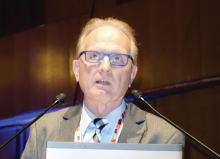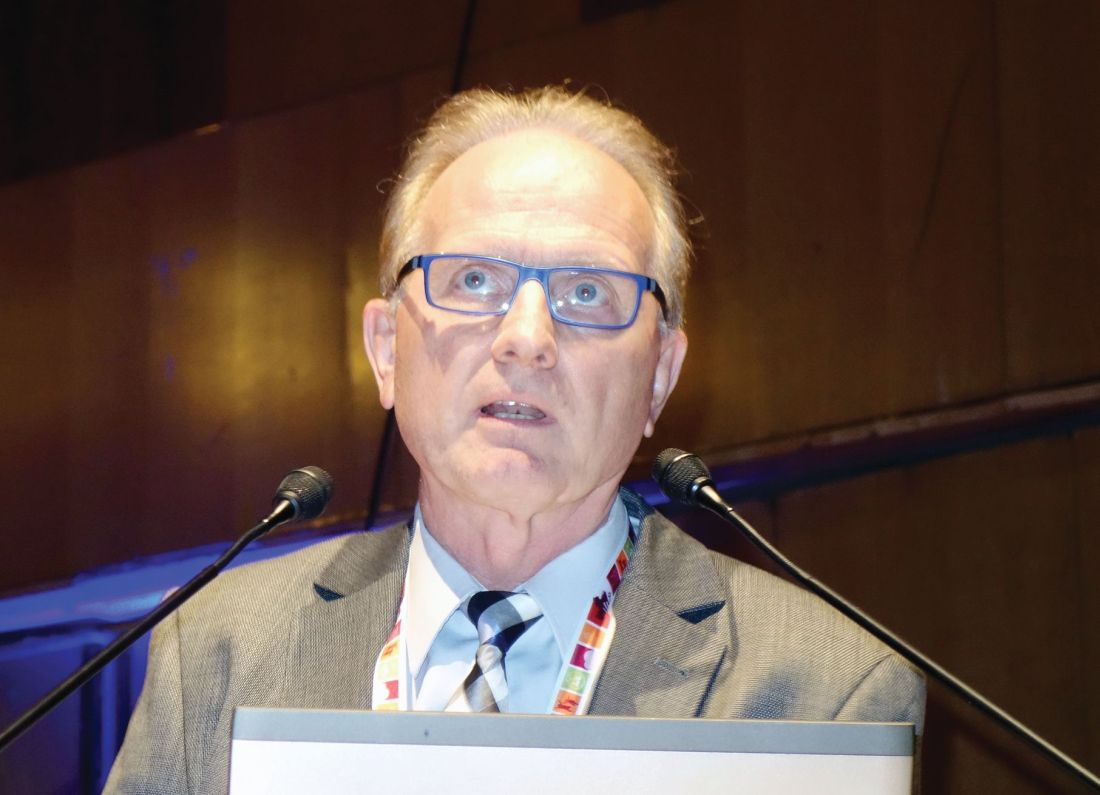User login
MADRID – One hundred percent of adolescents with chronic hepatitis C virus genotypes 1 or 4 had no detectable viral RNA present 12 weeks after completing a course of direct-acting antiviral therapy in the phase III ZIRCON study, Stefan Wirth, MD, reported at the annual meeting of the European Society for Paediatric Infectious Diseases.
Direct-acting antiviral therapy has revolutionized the treatment of chronic hepatitis C virus (HCV) in adults over the past several years as a result of its unprecedented efficacy, safety, brevity, and ease of use. The Study to Evaluate Treatment of Hepatitis C Virus Infection in Pediatric Subjects, also known as ZIRCON, is the first clinical trial to report treatment results in adolescents, noted Dr. Wirth, a pediatric hepatologist at the University of Witten/Herdecke in Germany.
The trial is an ongoing international open-label study of 12 or 24 weeks of ombitasvir/paritaprevir/ritonavir (Viekira) with or without dasabuvir (Exviera) and with or without ribavirin in 3- to 17-year-olds infected with HCV genotypes 1 or 4. Dr. Wirth presented short-term efficacy, safety, and pharmacokinetic results in 38 adolescents, one-third of whom previously had undergone unsuccessful pegylated interferon-based treatment.
The primary efficacy outcome was a sustained virologic response – that is, no detectable virus – 12 weeks after completing the course of treatment. This was achieved in all patients.
The multidrug regimens were well tolerated. There were no serious adverse events, no grade 3 or 4 laboratory abnormalities, and no study discontinuations tied to adverse events.
Dosing was the same as in adults: ombitasvir/paritaprevir/ritonavir at 25 mg/150 mg/100 mg once daily, dasabuvir at 250 mg twice daily, and weight-based ribavirin. The pharmacokinetic endpoints – maximum plasma concentration, trough concentration, and the area under the plasma concentration-time curve – were comparable to those seen in adults.
“That’s an important thing, because it means there doesn’t need to be dosage adjustment in treating adolescents,” Dr. Wirth said.
The seven patients with HCV genotype 4 infection with or without cirrhosis received 12 weeks of ombitasvir/paritaprevir/ritonavir and ribavirin. The 10 teens with genotype 1b infection with or without cirrhosis got 12 weeks of ombitasvir/paritaprevir/ritonavir with dasabuvir, as did 12 with genotype 1a or 1b disease without cirrhosis. Eight patients with genotype 1a disease without cirrhosis received ombitasvir/paritaprevir/ritonavir with dasabuvir and ribavirin.
Asked whether he would recommend that physicians begin treating HCV-infected teens with direct-acting antivirals, Dr. Wirth urged his colleagues to refrain.
“I don’t recommend any treatment now. We have to wait for approval of this new therapy in the adolescents. We should no longer use pegylated interferon with ribavirin, because it’s obsolete. There’s no harm in waiting for the next 1 or 2 years for the adolescent patients to be able to have an indication for the new direct-acting antiviral therapies,” he said.
ZIRCON outcomes in HCV-infected children aged 3-8 and 9-11 years will be reported later. All study participants will be followed for about 3.5 years after completion of treatment.
Dr. Wirth reported receiving research grants from AbbVie, which is funding the ZIRCON study.
MADRID – One hundred percent of adolescents with chronic hepatitis C virus genotypes 1 or 4 had no detectable viral RNA present 12 weeks after completing a course of direct-acting antiviral therapy in the phase III ZIRCON study, Stefan Wirth, MD, reported at the annual meeting of the European Society for Paediatric Infectious Diseases.
Direct-acting antiviral therapy has revolutionized the treatment of chronic hepatitis C virus (HCV) in adults over the past several years as a result of its unprecedented efficacy, safety, brevity, and ease of use. The Study to Evaluate Treatment of Hepatitis C Virus Infection in Pediatric Subjects, also known as ZIRCON, is the first clinical trial to report treatment results in adolescents, noted Dr. Wirth, a pediatric hepatologist at the University of Witten/Herdecke in Germany.
The trial is an ongoing international open-label study of 12 or 24 weeks of ombitasvir/paritaprevir/ritonavir (Viekira) with or without dasabuvir (Exviera) and with or without ribavirin in 3- to 17-year-olds infected with HCV genotypes 1 or 4. Dr. Wirth presented short-term efficacy, safety, and pharmacokinetic results in 38 adolescents, one-third of whom previously had undergone unsuccessful pegylated interferon-based treatment.
The primary efficacy outcome was a sustained virologic response – that is, no detectable virus – 12 weeks after completing the course of treatment. This was achieved in all patients.
The multidrug regimens were well tolerated. There were no serious adverse events, no grade 3 or 4 laboratory abnormalities, and no study discontinuations tied to adverse events.
Dosing was the same as in adults: ombitasvir/paritaprevir/ritonavir at 25 mg/150 mg/100 mg once daily, dasabuvir at 250 mg twice daily, and weight-based ribavirin. The pharmacokinetic endpoints – maximum plasma concentration, trough concentration, and the area under the plasma concentration-time curve – were comparable to those seen in adults.
“That’s an important thing, because it means there doesn’t need to be dosage adjustment in treating adolescents,” Dr. Wirth said.
The seven patients with HCV genotype 4 infection with or without cirrhosis received 12 weeks of ombitasvir/paritaprevir/ritonavir and ribavirin. The 10 teens with genotype 1b infection with or without cirrhosis got 12 weeks of ombitasvir/paritaprevir/ritonavir with dasabuvir, as did 12 with genotype 1a or 1b disease without cirrhosis. Eight patients with genotype 1a disease without cirrhosis received ombitasvir/paritaprevir/ritonavir with dasabuvir and ribavirin.
Asked whether he would recommend that physicians begin treating HCV-infected teens with direct-acting antivirals, Dr. Wirth urged his colleagues to refrain.
“I don’t recommend any treatment now. We have to wait for approval of this new therapy in the adolescents. We should no longer use pegylated interferon with ribavirin, because it’s obsolete. There’s no harm in waiting for the next 1 or 2 years for the adolescent patients to be able to have an indication for the new direct-acting antiviral therapies,” he said.
ZIRCON outcomes in HCV-infected children aged 3-8 and 9-11 years will be reported later. All study participants will be followed for about 3.5 years after completion of treatment.
Dr. Wirth reported receiving research grants from AbbVie, which is funding the ZIRCON study.
MADRID – One hundred percent of adolescents with chronic hepatitis C virus genotypes 1 or 4 had no detectable viral RNA present 12 weeks after completing a course of direct-acting antiviral therapy in the phase III ZIRCON study, Stefan Wirth, MD, reported at the annual meeting of the European Society for Paediatric Infectious Diseases.
Direct-acting antiviral therapy has revolutionized the treatment of chronic hepatitis C virus (HCV) in adults over the past several years as a result of its unprecedented efficacy, safety, brevity, and ease of use. The Study to Evaluate Treatment of Hepatitis C Virus Infection in Pediatric Subjects, also known as ZIRCON, is the first clinical trial to report treatment results in adolescents, noted Dr. Wirth, a pediatric hepatologist at the University of Witten/Herdecke in Germany.
The trial is an ongoing international open-label study of 12 or 24 weeks of ombitasvir/paritaprevir/ritonavir (Viekira) with or without dasabuvir (Exviera) and with or without ribavirin in 3- to 17-year-olds infected with HCV genotypes 1 or 4. Dr. Wirth presented short-term efficacy, safety, and pharmacokinetic results in 38 adolescents, one-third of whom previously had undergone unsuccessful pegylated interferon-based treatment.
The primary efficacy outcome was a sustained virologic response – that is, no detectable virus – 12 weeks after completing the course of treatment. This was achieved in all patients.
The multidrug regimens were well tolerated. There were no serious adverse events, no grade 3 or 4 laboratory abnormalities, and no study discontinuations tied to adverse events.
Dosing was the same as in adults: ombitasvir/paritaprevir/ritonavir at 25 mg/150 mg/100 mg once daily, dasabuvir at 250 mg twice daily, and weight-based ribavirin. The pharmacokinetic endpoints – maximum plasma concentration, trough concentration, and the area under the plasma concentration-time curve – were comparable to those seen in adults.
“That’s an important thing, because it means there doesn’t need to be dosage adjustment in treating adolescents,” Dr. Wirth said.
The seven patients with HCV genotype 4 infection with or without cirrhosis received 12 weeks of ombitasvir/paritaprevir/ritonavir and ribavirin. The 10 teens with genotype 1b infection with or without cirrhosis got 12 weeks of ombitasvir/paritaprevir/ritonavir with dasabuvir, as did 12 with genotype 1a or 1b disease without cirrhosis. Eight patients with genotype 1a disease without cirrhosis received ombitasvir/paritaprevir/ritonavir with dasabuvir and ribavirin.
Asked whether he would recommend that physicians begin treating HCV-infected teens with direct-acting antivirals, Dr. Wirth urged his colleagues to refrain.
“I don’t recommend any treatment now. We have to wait for approval of this new therapy in the adolescents. We should no longer use pegylated interferon with ribavirin, because it’s obsolete. There’s no harm in waiting for the next 1 or 2 years for the adolescent patients to be able to have an indication for the new direct-acting antiviral therapies,” he said.
ZIRCON outcomes in HCV-infected children aged 3-8 and 9-11 years will be reported later. All study participants will be followed for about 3.5 years after completion of treatment.
Dr. Wirth reported receiving research grants from AbbVie, which is funding the ZIRCON study.
AT ESPID 2017
Key clinical point:
Major finding: Twelve weeks after adolescents with hepatitis C genotype 1 or 4 virus infection completed a course of direct-acting antiviral therapy, none had any detectable virus.
Data source: Interim report from an ongoing international open-label phase III study of 38 adolescents with chronic hepatitis C infection treated with direct-acting antiviral agents.
Disclosures: The study presenter reported receiving research grants from AbbVie, which is funding the ongoing ZIRCON study.

